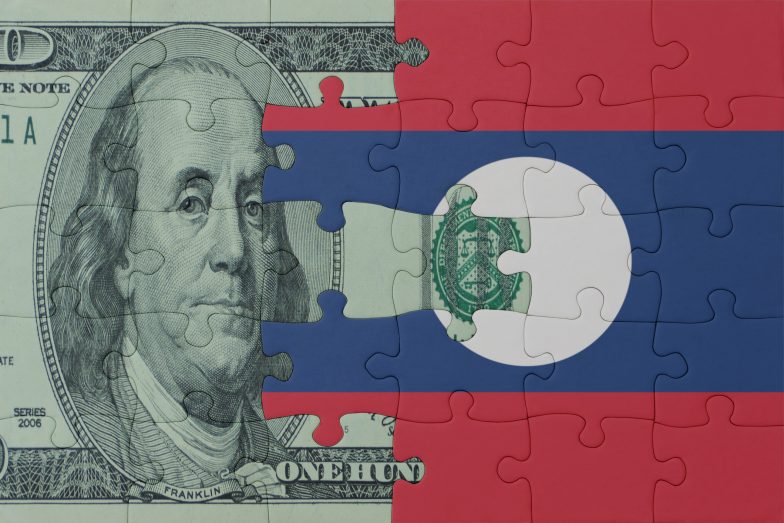
Laos posted an annual average growth in its gross domestic product (GDP) of more than 7 percent between 1985 and 2019. That was nothing short of an “economic miracle.” That said, since 2019 the country’s economic growth has petered out not only due to the outbreak of COVID-19 but also because of the country’s huge debt overhang.
According to the Asian Development Bank’s “Country Partnership Strategy for Lao PDR,” published in February, the size of the country’s economy shrank from about $18.7 billion in 2019 to $14.1 billion by 2023. During the same period, the country’s per capita GDP declined from $2,600 to $1,858. The Lao kip depreciated from just under 14,000 per U.S. dollar in 2021 to around 24,000 in 2023. Meanwhile, annual inflation skyrocketed from about 3.0 percent in 2019 to 31.2 percent in 2023. The worsening economic conditions have put severe pressure on the poor and the vulnerable sections of the country’s 7.5 million people.
Using a whole gamut of stress tests, in May 2023, the International Monetary Fund gave its verdict: Laos is in debt distress. Highlighting the fact that Laos’ public debt rose from 69 percent of GDP in the pre-COVID-19 years to 128.5 percent in 2022, and concomitantly, that interest payments rose from 10 percent of public revenues in 2019 to 24 percent in 2022, Credendo, a European Trade Credit Insurer, has cautioned that the country is sinking towards a sovereign debt default. In February of this year, Moody’s put Laos’ sovereign credit rating far below investment grade. The immediate challenge for Laos is to effectively address its huge debt overhang – by whatever means necessary.
In response to the crisis, Laos’ government introduced draconian controls. It instructed the Ministry of Finance to collect taxes and revenues from businesses and exporters in foreign currencies, in case these businesses earned income in foreign currencies; ordered the Bank of Lao (BOL) to improve its electronic payment system; and asked the Ministry of Industry and Commerce to develop an electronic payment system that enabled the sharing of data with BOL. It also instructed importers and exporters to compulsorily hold bank accounts; insisted that exporters who wanted to keep their earnings in foreign currencies abroad should seek prior permission from the BOL; and banned anyone, other than a foreign expert or an expat employee, from receiving their salaries in foreign currencies. The prime minister instructed government officials to strictly police the implementation of these measures.
Ironically, the long list of control measures is being introduced at a time when the country requires exactly the opposite: policy liberalization. Encouragingly, Laos now needs a simple liberalization program that would link up the small land-locked country into the global economy. That, in turn, underscores the need for the country to implement a three-pronged liberalization program: privatize the economy; remove most, if not all, the controls on the country’s external trade and capital flows; and finally, and most importantly, dollarize the economy. The country could and should implement the three-pronged reforms as quickly as possible. Given space constraints, I will focus on the lynchpin of the reform program: dollarization.
Being a small economy with inadequate human capital, Laos is an ideal candidate for more, not less, dollarization. It has two options to consider. It could go for de jure dollarization, under which the dollar formally replaces the kip. If it is not politically palatable to do away with the kip, then the second option could be de facto dollarization. Under this system, the government could keep the kip but then maintain a dollar-kip parity, so that the kip remains as a unit of account, but not as a medium of exchange and a store of value. Rather than using its scarce human capital in managing a national currency, BOL would then have more time on its hands to effectively implement its regulatory and supervisory functions over the country’s financial system.
In January 2003, Alberto Alesina and Robert J. Barro published a paper titled “One Country, One Currency?” which posed the question: Just because the number of countries has increased sharply since the Second World War, is there a need for each new country to have a new currency? Their answer was a simple “no.” To paraphrase their argument, there was simply no good economic reasoning for “each national flag” to have a “new currency.” In subsequent papers, other economists showed that the sharp rise in the number of currencies has not only hindered international trade but also caused more currency crises around the world.
Encouragingly, at one stroke, the introduction of the euro in 1999 consolidated a large number of European nations’ currencies. From their sheer experience, the European countries figured out that, left to themselves, each of them would continuously go through competitive currency devaluations, harming the entire region’s socioeconomic development. More recently, the intergovernmental regional block commonly known as BRICS, which includes founding members Brazil, Russia, India, China, and South Africa as well as Iran, Egypt, Ethiopia, and the United Arab Emirates, is also considering introducing a common currency for the group as a whole. It may sound like a dream – but one could have said the same thing about the European Monetary Union before the euro was introduced. The Euro is now one of the most important currencies in the world, used by more than 350 million people.
Nearer home to Laos, Cambodia has used de facto dollarization well since the early 1990s. Along with Cambodia’s highly open economic policies, the de facto dollarization has contributed to Cambodia’s own sustained period of economic growth. The country’s financial system allows banks to accept dollar-denominated deposits as well as to make dollar-denominated loans. Laos thus has a good example in one of its neighbors that has done well socioeconomically by adhering to de facto dollarization. More than anything else, the de facto dollarization had boosted the confidence of both domestic and foreign investors in the Cambodian economy. It also protected the economy from the harsh effects of the 1997-1998 Asian Financial Crisis.
If all this evidence does not convince Laos to dollarize its economy at this crucial stage of its debt crisis, it is hard not to imagine the country simply traversing from the current crisis to another. The country’s day of reckoning has come. The country badly needs more dollarization, whether de jure or de facto.
The views expressed in this paper are entirely those of the author and should not in any way be attributed to the Pannasastra University of Cambodia and/or Asian Development Bank.






